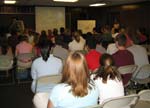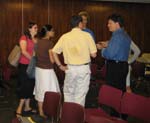
The master planning effort has been underway since July 2005. Boston College selected Sasaki Associates to assist in the planning process. Sasaki is working with an Executive Committee as well as a number of advisory committees.
Phase 1
The first phase of the master planning process is characterized as the reconnaissance phase. In this phase, the Sasaki representatives met with a number of campus advisory groups to gather information about the campus from their unique perspectives. There were also several meetings held with undergraduate and graduate students to explore their visions of the future of Boston College. To date, there have been close to 100 meetings held regarding the Master Plan. There have also been monthly Executive Committee meetings to review the process and progress of the development of the Master Plan.
In Phase I, Sasaki performed a comprehensive campus/environs analysis, program analysis, building evaluations, and circulation and parking analysis. Below are some of their observations and tools for analysis.
Boston College Campuses (PDF
2.2MB)
Campus Uses (PDF 65KB)
Aerial Views of the Campus
(PDF 900KB)
Site Topography (PDF 2.2MB)
Summary of Observations
(PDF 1.2MB)
|



Project Team met with Undergraduate and Graduate Students in September
|